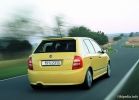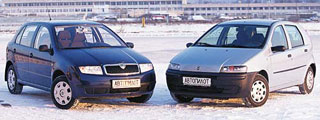Skoda Fabia 2000 test drive - 2007 -
Skoda Fabia SDI: Turbo Fabia
Why do Belarusians love diesel cars? The answer to this question can be sought for a long time, but it lies on the surface: a banal thirst for savings. Previously, five to six years ago, few of the buyers of new cars thought about real fuel consumption. It was believed that a person who has money for such a car always has a stitch on fuel. It was partly true: buyers of limousines and eight -cylinder SUVs were really not interested in these parameters, although there were still exceptions. But against the general background of abundance of new models with gasoline engines, the appearance of one or two with a turbodiesel was considered only as a confirmation of the rule.Now other times, crazy money has disappeared as quickly as they came, and economical cars gradually come into fashion. Moreover, interestingly, everyone began to save: both the buyers of small -sized and those who look closely at prestigious SUVs. But since our motorists are not used to traveling on slow and very weak models, their attention was not switched to budget models, but to cars with turbodiesel engines. Profitable, I’ll tell you, this is the latest turbodiesel: it works almost as quietly as modern gasoline, pulls even better, more economically, and also has an excellent torque at low speeds, which is very convenient for novice drivers, and also to motorists who are the main mileage on trips around the city ...
The main criteria for which diesel engines are evaluated is the noise of the engine working in various modes of the motor and traction, which greatly affects accelerating dynamics and elasticity. It is not customary to talk about efficiency in this case: diesel machines in any case consume less fuel than gasoline with a commensurate with the volume of the engine, and it is still inexpensive diesel fuel.
Although recently it has become more expensive than the 76th gasoline, the turbodiesel is still more profitable in the calculations. Even in the most stringent modes, he consumes a maximum of 7-8 liters, while the gasoline analogue of the same volume can easily eat and all 12. The topic of fuel saving is especially relevant when you are traveling on your pseudo-economic gasoline low-profile in the city with a loaded luggage. And five dense passengers in the cabin. In such modes, all poorly energy -armed cars, experiencing an acute flaw in horses and Newtonometers of torque, begin to eat for three, and at the same time they go as if they were death. It is useless to promote the engine to high speeds, as well as trying to move at the moment, it is useless: the car is all the same, and it will not be able to achieve anything more from it. It remains only to go slowly and pray that it all ends quickly ...
For Skoda Fabia, one of the most popular cars of our market, two options for diesel engines of the same volume, but of various capacities are offered. The basic version is equipped with a 1.9-liter 64-horsepower atmospheric engine, with direct fuel injection and four valves per cylinder.
A more powerful version, also 1.9-liter, has a turbocharger with electronic adjustment of the geometry of the turbine and pump, and develops a capacity of 101 hp. It is a pity, of course, that we did not find buyers for such a car, because more than a hundred diesel horses in such a small car - this, I tell you, the rocket is cleaner than a 2.0 -liter gasoline. With such a margin of torque, you can drive no worse than on GTI gasoline, and it is very unfortunate that few people understand a lot about such machines. Our consumers choose cars easier and cheaper. Such as the Skoda Fabia 1.9 SDI tested by us. There is such a car in the Comfort 9.240 EUR configuration - inexpensive, given that our market is generally few inexpensive diesel hatchbacks of a small class. You can familiarize yourself with the configuration in more detail at the end of the article, and I would additionally note only the fact that the air conditioner in this machine is standardly installed only on the most expensive version, for everyone else this suburb is an option. We have repeatedly told about the running qualities, internal space and other features of the Fabia models family: all gasoline versions have visited our tests, with the exception of the most powerful 2.0-liter. We also tested modifications with the bodies of the sedan and the station wagon, which, according to the tradition of the company, is called Combi. Only diesel engines remained, and we did not deny ourselves the pleasure of traveling once again on this wonderful car.
The first impression of diesel Fabia - it is not as bad as you might think about it, studying the technical characteristics. Despite the fact that babies rarely indulge in buyers with an abundance of the latest technical know-how and in general a high level of manufacture, Fabia with a diesel engine at first even causes amazement. In the first discipline, that is, in terms of the voteness of the motor, Fabia immediately takes almost the first position, bypassing many more eminent and much more expensive competitors. For example, a 1.9-liter VW Passat works louder and more tough, and the rest are also far from imitation samples. Honestly, I thought that Fabia would also not be so hot: they rarely have good expensive motors on affordable low -commissions.
But everything turned out to be completely different, and the Czech small science once again pleased us with a very profitable ratio of price and quality, and also surprised us with a good and painful diesel. All of his 64 horses not in vain eat their bread: the car is eager for battle from the bottom, without forcing to play with gas or clutch. In general, this is a find for a novice driver. In order to drown out the Fabia SDI at a traffic light, you need to specially throw the clutch, in all other cases the motor desperately pulls the car. True, not to say that he also worked excellently in the rest of the range, in motion would not hurt a little liveliness at high speeds. There is no characteristic for modern TDI undermining, but on any gear, the motor serenely pulls from idle speeds, which provokes the driver not to switch as long as possible.
My personal experiment proved that even with 35 km/h in the fifth gear Fabia SDI can accelerate, without making any resonating sounds and not vibrating the entire body. It seems that for her such bullying is a matter of granted, a trifle. Against the background of those failures at low speeds that recently demonstrated diesel Mazda MPV and Hyundai Santa Fe, a hardworking, although not the most dynamic Fabia motor is perceived as more convenient. You do not need to constantly switch, because you can use all those 125 nm that it develops at 1600 rpm! That is, even if you roll on a fully loaded car along a loaded street at a speed of 35-40 km/h, you can turn on the fifth with a light heart and forget about it: at the right time, the car will gain speed. Let not very quickly, but without tension, without forcing the driver to feed it with reduced gears. By the way, about reduced gears: their use is not a panacea from all troubles, because even constantly switching, it is difficult to achieve a decent dynamics of a gasoline car from Fabia SDI: the engine has an extremely gentle curve of torque. That is, in the entire range of revolutions, he has no bursts or failures, and he doesn’t care even for him, for 2000 or 4000 rpm, he works about the same craving.
Skoda Fabia, regardless of the type of body or power of the motor, is one of the most attractive options for the purchase, even though the car is relatively for a long time in the market, and many of its competitors have passed modernization, or even completely transformed by a new generation. If your car does not stand for weeks in the parking lot and every year new five -digit numbers appear on its odometer, then, even despite the relatively high cost, Skoda Fabia SDI is a car for you. With its efficiency, and the average fuel consumption of the SDI version is about 5 liters per hundred kilometers, you can justify the content literally after a year and a half, and in the future there is no large costs-the car is still new ...
(+) Quiet engine, high -quality interior, good equipment.
(-) a relatively high price, mediocre dynamics.
Text: Pavel Kozlovsky
Video crash tests Skoda Fabia 2000 - 2007
Skoda Fabia 2000 test drives - 2007
Skoda Fabia 2000 - 2007 crash test
Krassh Test: Detailed Information26%
Driver and passengers
12%
Pedestrians











